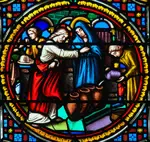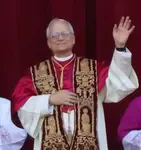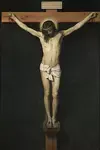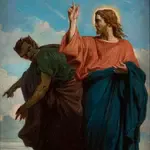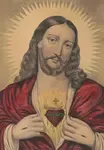RESURRECTION REMEMBRANCES
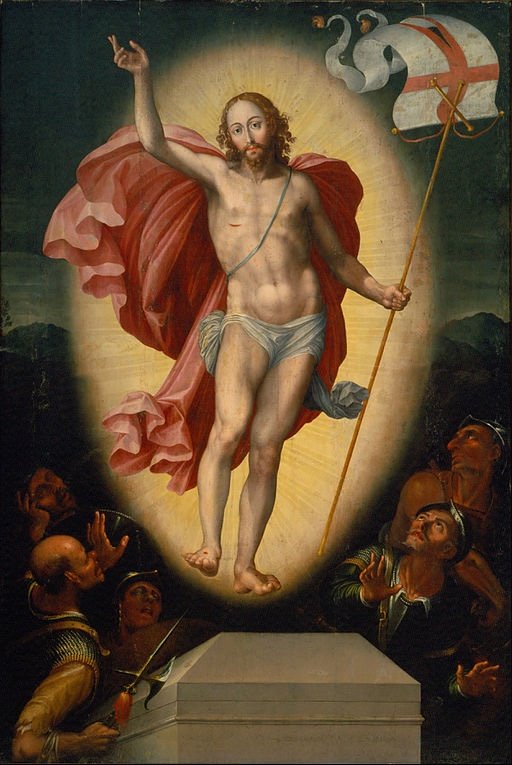
THE FIVE FIRST SATURDAYS IS A DEVOTION NEEDED NOW MORE THAN EVER! FIND OUT MORE HERE
THE SAINT MICHAEL PRAYER AND THE ROSARY
ARE ALSO POWERFUL PRAYERS TO HELP US THROUGH THESE VERY TURBULENT TIMES!
HIGHLY RECOMMENDED! DELIVERANCE PRAYERS,
A BOOK FROM SENSUS TRADITIONIS PRESS
(A GREAT PUBLISHER HELPING US FIGHT OUR MANY SPIRITUAL BATTLES NOWADAYS)!
CHECK OUT OUR PODCAST PAGE AND OUR YOUTUBE CHANNEL FOR INSPIRING CONTENT
THIS WEBPAGE IS ALSO AVAILABLE
AS A PODCAST HERE
Resurrexit Sic Ut Dixit! He is Risen as He Said! Alleluia! During the Lenten Season, we give special attention as Catholics to our Lord’s Passion and Death, such as during public recitations of the Stations of the Cross.
But the somber mood of Lent quickly gives way to joy at the Easter Vigil, and on Easter Sunday itself, as we focus on our Risen Lord and His triumph over death in His Resurrection in which he opened the gates of heaven for our salvation.
Some scriptural verses can give us food for thought, and can be helpful when meditating on the first Glorious Mystery of the Rosary, the Resurrection of our Lord and Savior Jesus Christ. We also have a separate page on the Glorious Mysteries of the Rosary here.
The Biblical quotations that follow are taken from the excellent Revised Standard Version, Second Catholic Edition of the Ignatius Study Bible, which seeks modern day linguistic clarity while preserving fidelity to the meaning of the texts found in traditional earlier Bibles, such as the famous Douay-Rheims Bible published first in full in the 17th Century.
These verses remind us all that, as St. Peter would later write when speaking of our Lord’s Transfiguration, For we did not follow cleverly devised myths when we made known to you the power and coming of our Lord Jesus Christ, but we were eyewitnesses of his majesty….for we were with him on the holy mountain (2 Pet 1:16, 18).
As a reminder, in the Transfiguration, which took place during Jesus’ earthly ministry, our Lord shone in dazzlingly bright glory while speaking with Moses and Elijah, who represented the Law and the Prophets respectively. And then, Jesus' Heavenly Father in a bright cloud praised Him in what must have been a truly awesome moment for Peter, James, and John witnessing this great event!
We get an intriguing collection of insights from the separate Gospel accounts about Jesus’ Resurrection, particularly those from St. Luke and St. John. These include St. Luke’s account of the disciples on the road to Emmaus and St. John’s account of Christ’s stirring rebuke to St. Thomas’ refusal to believe in our Lord’s Resurrection beforehand.
And as if to add further to the veracity of these accounts, St. Luke gives us this essential bit of information in his introduction to his other monumental work The Acts of the Apostles when he writes of Jesus that He presented himself alive after his passion [to His apostles] by many proofs, appearing to them during forty days, and speaking of the kingdom of God (Acts 1:3). Note those key words: “forty days” and “many proofs”.
In sum we can go to the words Christ gave to his apostle Thomas: do not be faithless, but believing (John 20:27), so as St. John, would also write, that you may believe that Jesus is the Christ, the Son of God, and that believing you may have life in his name (John 20:31).
With that in mind, here are some thoughts on certain scriptural references to our Lord’s Resurrection:
For starters, we have this verse from Mark’s Gospel as a preview of sorts, which follows directly after Christ’s incredible Transfiguration on Mount Tabor, mentioned earlier. Jesus is giving his beloved apostles an important order:
And as they were coming down the mountain, he charged them to tell no one what they had seen, until the Son of man should have risen from the dead. So they kept the matter to themselves, questioning what the rising from the dead meant (Mark 9:9-10).
Can you just imagine what was then going through these three apostles’ minds having been witnesses to this monumental event mentioned above? Perhaps they said to our Lord, in effect “Sure Boss [Master] no problem” and then asked each other quizzically “Hey what does that mean?”
Now we fast forward to events after the Resurrection itself. Keep in mind that now the disciples’ eyes were opened as to what Jesus had meant when He spoke of rising from the dead in his predictions in His earthly ministry, as evidenced in another famous miracle involving the disciples on the road to Emmaus.
When he was at table with them, he took the bread and blessed and broke it, and gave it to them. And their eyes were opened and they recognized him; and he vanished out of their sight (Luke 24:30-31).
Suddenly Jesus wasn’t just some stranger to whom they were extending hospitality! Much as we are called to do in every Mass today, they recognized Jesus in the breaking of the bread, as in the Eucharistic prayers at Mass said to consecrate what was once bread into the body, blood, soul, and divinity of Jesus Himself!
And what came next is also noteworthy:
They said to each other, "Did not our hearts burn within us while he talked to us on the road, while he opened to us the Scriptures?" (Luke 24:32)
“They” in this case refers to the disciples on the road to Emmaus. Jesus had just given them what must have been an incredible talk of how and where He was referred to in the Old Testament. Saint Augustine once observed that the “New Testament lies hidden in the Old and the Old Testament is unveiled in the New.”
That must have been some lesson! Pity they didn’t didn’t copy down His words on scrolls. All the more so, considering that voice recording (from phonograph records to tape to smartphones and such today) wouldn’t come into being for about another 19 centuries!
These two disciples went back to Jerusalem, and, as further recorded in Luke’s Gospel, they were told by other disciples that the Lord had indeed risen and appeared to Simon (that is to say Peter)(Luke 24:36-43)!
And then shortly afterwards:
Jesus himself stood among them, and said to them, "Peace to you." But they were startled and frightened, and supposed that they saw a spirit. And he said to them, "Why are you troubled, and why do questionings rise in your hearts? See my hands and my feet, that it is I myself; handle me, and see; for a spirit has not flesh and bones as you see that I have." And when he had said this he showed them his hands and his feet. And while they still disbelieved for joy, and wondered, he said to them, "Have you anything here to eat?" They gave him a piece of broiled fish, and he took it and ate before them (Luke 24:36-43).
Can you imagine the flabbergasted joy the disciples must have felt? After all, a ghost can’t eat a piece of fish!
And remember that it was only a short time later that Jesus would, as affirmed with magisterial weight by the Council of Trent in the 16th century, institute the Sacrament of Penance.
This would enable those present, along with a multitude of priests throughout the centuries to come, up until the present time, to act “in persona Christi” (as they say, "in the person of Christ") in the confessionals.
Jesus said to them [the disciples] again, "Peace be with you. As the Father has sent me, even so I send you." And when he had said this, he breathed on them, and said to them, "Receive the Holy Spirit. If you forgive the sins of any, they are forgiven; if you retain the sins of any, they are retained" (John 20:21-23).
But still, there was a Doubting Thomas who inadvertently gave us further proof of the authenticity of Jesus' “rising from the dead”.
Now Thomas, one of the Twelve, called the Twin, was not with them when Jesus came. So the other disciples told him, "We have seen the Lord." But he said to them, "Unless I see in his hands the print of the nails, and place my finger in the mark of the nails, and place my hand in his side, I will not believe." Eight days later, his disciples were again in the house, and Thomas was with them. The doors were shut, but Jesus came and stood among them, and said, "Peace be with you." Then he said to Thomas, "Put your finger here, and see my hands; and put out your hand, and place it in my side; do not be faithless, but believing." Thomas answered him, "My Lord and my God!" Jesus said to him, "You have believed because you have seen me. Blessed are those who have not seen and yet believe" (John 20:24-29).
And finally, after Peter’s reaffirmation as the head of Jesus’ church following his previous denial of Him the night before our Lord’s crucifixion, we have these intriguing lines that can apply not only to Peter as Jesus’ appointed head of the church but to us as well, in a different sort of way.
We read that Peter turned and saw following them the disciple whom Jesus loved [St. John]...When Peter saw him, he said to Jesus, "Lord, what about this man?" Jesus said to him, "If it is my will that he remain until I come, what is that to you? Follow me!" (John 21:20-22).
And while those words caused some confusion that John would be present when Jesus returned in glory at His Second Coming, the apostle hastens to point out Jesus is asking here asking a purely hypothetical question.
We can be similarly inspired by these words not to give in to spiritual jealousy or needless concerns about others’ standing in the church, but rather to keep focused on discerning the mission that Jesus has for each one of us, instead of focusing on that of others.
These post-resurrection Gospel accounts indeed contain a great deal of wisdom! Jesus challenges us all to have faith to believe in Him as “true God from true God” who indeed “rose again on the third day in accordance with the Scriptures” as we say in the Nicene Creed. And that, as St. John would say, as mentioned earlier, that you may believe that Jesus is the Christ, the Son of God, and that believing you may have life in his name (John 20:31).
FROM OUR BOOK AND GIFT STORE
OR CAFE PRESS STORE!
Return from Resurrection Remembrances
to Prayer Blog Page






